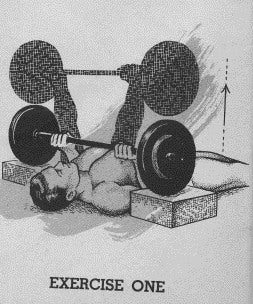If you were born after 1950, you’ve never known a world in which commercial gyms failed to feature weight benches as a center-ring attraction. Prior to this, most gym-goers who wanted to grow their chest muscles were forced to work within the limitations of push-ups and bodyweight dips, with others relying on early iterations of cable-pulley systems, exercise springs and elastic bands.
This doesn’t mean that a bench-pressing approximation didn’t exist, or that people didn’t attempt to replicate the practice through other means. But the limitations were obvious. The strongman, authentic professional wrestler and all-around pioneer of strength training — George Hackenschmidt — was said to be able to arrange his body in a wrestler’s bridge, pull a 335-pound barbell from the floor to his chest while in that physical configuration and then press it upward. He even developed a special configuration for his floor press with the barbell resting on blocks.

Are there any benefits to doing the floor press?
There are several, but I’ll assume that you’re doing the floor press in the fashion that Hackenschmidt advised.
First of all, the starting position of the floor press, with the barbell resting on blocks, means that your initial interaction with the bar is a concentric contraction, where you apply the force and the bar moves in its intended direction. Basically, you don’t have to lift it from an elevated position, move it slightly in the direction of your feet and then lower it toward your chest.
The floor press also features fewer risks of suffering a catastrophic injury as a result of failure, since the bar is merely lowered back to its starting point without you being obligated to re-rack it or die. Similarly, as long as your form isn’t sloppy, there’s a reduced likelihood that you might be injured during your lift — for a couple of reasons. To start, the bar is unlikely to make contact with your chest at any point during the pressing activity, so you don’t risk damage to your chest. Second, your elbows obviously have no ability to creep beneath the floor, resulting in less vulnerability to your shoulders.
Obviously, all of these advantages go out of the window if the weight manages to roll on top of you. While a bailout technique exists on the bench press that’s fairly easy to execute if you can maintain your wits about you and the bar is unclasped, pressing from the floor eliminates this option. So the floor press adds to the level of safety over a bench press in some respects, but it does raise the potential peril in others.
This sounds mostly good! So what are the downsides?
Let’s start on a minor note with your ability to add and remove weight from the bar. Rapidly adjusting the weight total of a suspended weight bar is significantly easier than doing so when the bar is resting on the floor or propped on blocks. This isn’t a conversation-ender, but it’s worth noting.
Next, it’s effectively impossible to alter the angle of this exercise the way you can if it’s performed from a bench. Unless I’m missing something, there’s no such thing as a floor press from an inclined or declined angle; the exercise is always performed while your body is parallel to the very floor that it’s resting upon.
Finally, bench-pressing purists — who I tend to disagree with — will tell you that the bar absolutely must make contact with your chest in order for a lift to be legitimate, an option pressing from the floor doesn’t typically grant, because, again, the ground tends to get in the way.
So would you ever do a floor press?
With dumbbells and lighter weight? Probably. There are certainly some variations of pressing a dumbbell from the floor that I find appealing, and the built-in safety measures come in handy. However, would I ever try a barbell bench press from the floor? Probably not — for all the reasons above.
But if you decide to lie on the floor to engage in your best approximation of an old-time strongman’s training routine, make sure you have a good reason for doing so, and that you’ve got all of the proper safety measures in place. Also, consider whether or not it’s truly a good idea. After all, George Hackenschmidt himself probably would have given up the floor the moment he had access to a weight bench, too.

